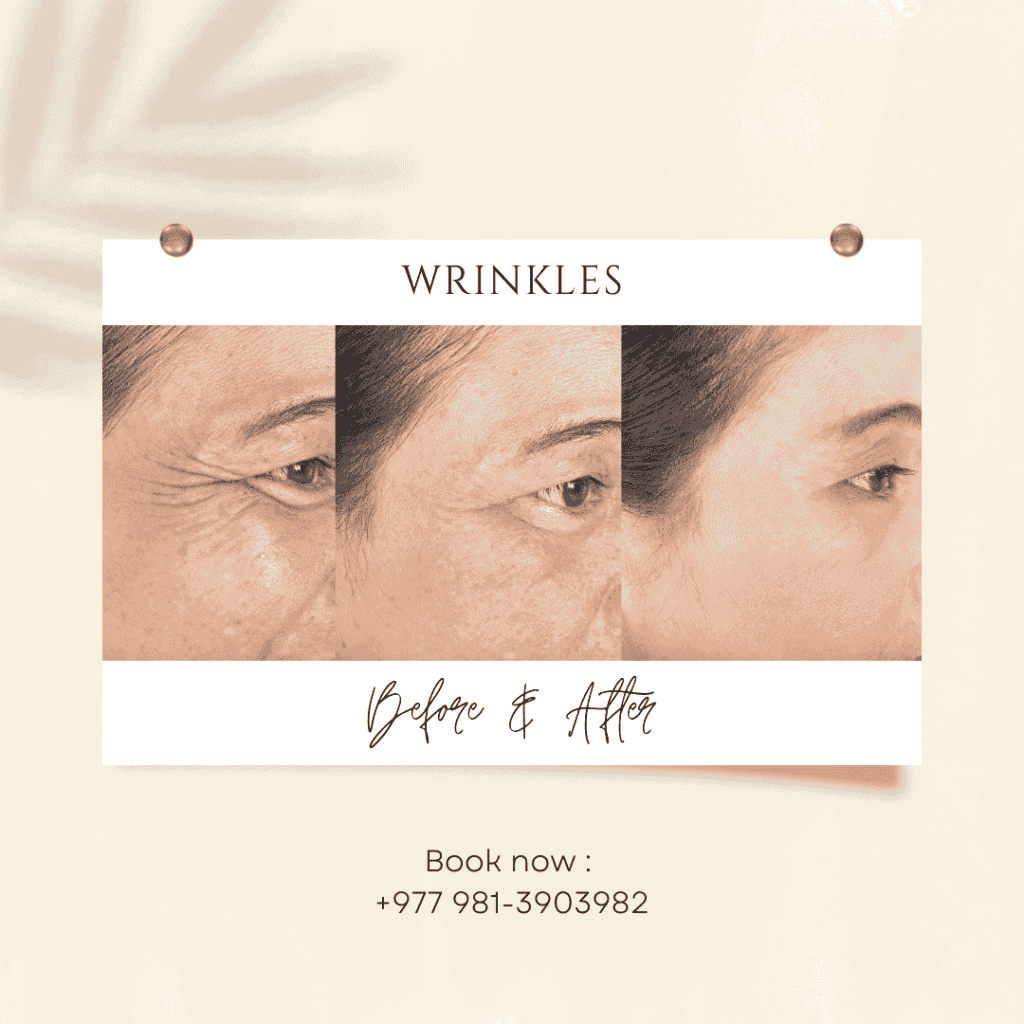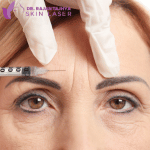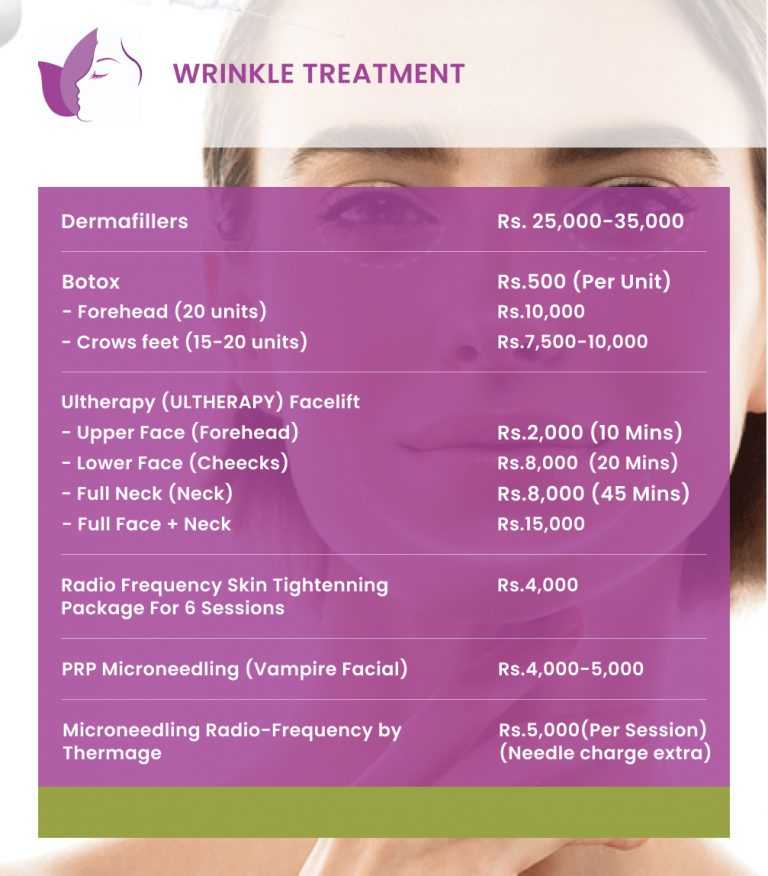
Understanding Wrinkles: Causes, Treatments, and Prevention
Wrinkles are a normal part of aging. mainly happen on the parts of the body that get the most sun exposure, including the face, neck, the backs of the hands, and the tops of the forearms.wrinkles fall into two categories: fine, surface lines and deeper furrows.
Causes
- With aging, the skin naturally becomes less elastic and drier, with less fat and collagen in the deeper layers. This process results in the lines and creases typical of wrinkling. It also causes loose, saggy skin.
- Ultraviolet (UV) radiation.Ultraviolet radiation from sunlight and other sources speeds the skin’s aging process, especially in people who tend to sunburn easily. It breaks down the elastin fibers and collagen in skin.
- Smoking and pollution.Smoking and air pollutants speed the aging process.
- Repeated facial expressions.Facial movements and expressions lead to fine lines and wrinkles. For example, every time you squint, smile and frown, tiny grooves form beneath the surface of the skin. As skin ages, it loses its flexibility and can no longer spring back. These grooves then become features of the face.
- Family history.The genes you inherit play a big part in the look and feel of your skin.
Contributing Factors
Wrinkles are caused by a combination of factors, including:
- Aging skin naturally becomes less elastic, thinner, and more fragile. The production of natural oils decreases, causing the skin to become drier and more prone to wrinkling.
- Ultraviolet (UV) light from the sun speeds up the natural aging process, causing the skin to lose collagen and elastin, which are essential for maintaining skin elasticity and firmness.
- Repeated facial expressions, such as smiling, frowning, or squinting, can cause wrinkles to form due to the constant flexing of facial muscles.
- Smoking can cause a reduction in the production of new collagen, leading to premature facial wrinkling.
- Pollutants and other environmental factors can contribute to the formation of wrinkles by damaging the skin’s collagen and elastin fibers.
- Our genes largely control when and how our skin ages, which can influence the development of wrinkles.
- The constant downward pull of gravity on the skin can cause it to sag, leading to the formation of wrinkles and folds.
Treatment Options
A wide range of treatment options are available to treat wrinkles, including non-invasive and invasive procedures. Some of the most common treatments include:
- CHEMICAL PEELS: These treatments involve applying a chemical solution to the skin, causing it to exfoliate and eventually peel off, revealing smoother, less wrinkled skin underneath.
- MICRONEEDLING: This procedure involves creating tiny punctures in the skin using fine needles, stimulating collagen production and improving skin texture.
- LASER SKIN RESURFACING: This treatment uses lasers to remove the outer layer of skin and stimulate collagen production in the underlying layers, resulting in smoother, firmer skin.
- NEUROTOXINS/NEUROMODULATORS: BOTOX and JEUVEAU injections can temporarily relax facial muscles, reducing the appearance of wrinkles caused by repeated facial expressions.
- DERMAL FILLERS: Injectable fillers, such as those containing hyaluronic acid, can help plump up the skin and smooth out wrinkles
What are the treatment options for wrinkles?
Botox:
Botulinum toxin A inhibits the release of acetylcholine, relieving muscle contraction and spasm associated with many conditions, such as incontinence and dystonia. Cosmetically, botulinum toxin A paralysis muscles in the face to temporarily treat wrinkles.

Laser Resurfacing:
Laser resurfacing is a procedure that uses an energy-based device to improve the look and feel of skin. It’s usually used to reduce fine lines, age spots and uneven skin color in the face. But it can’t fix sagging skin.
Laser resurfacing can be done with various devices:
- Ablative laser.This method uses a beam of energy to destroy the outer layer of skin and heat the underlying skin. This stimulates the growth of collagen — a protein that improves skin firmness and texture. As the wound heals and skin regrows, the treated area is smoother and tighter. Types of ablative lasers include carbon dioxide (CO2) lasers, erbium lasers and combination systems.
- Nonablative laser or light source.This method also stimulates collagen growth. It’s less aggressive than an ablative laser and results in a shorter recovery time. But the results are subtle. Two types of non-ablative therapy are erbium (Er:YAG) and intense pulsed light (IPL).
Both ablative and nonablative methods can be done with a fractional laser, which leaves microscopic columns of tissue that’s not treated throughout the treatment area. Fractional lasers shorten recovery time and reduce the risk of side effects. It will need more than one treatment session. Use of fractional devices has become the widely preferred method.
Micro needling with plasma-rich platelets (PRP):
Micro-needling with plasma-rich platelets (PRP) uses part of the blood from the person having the procedure to rejuvenate the skin.
Microneedling is a cosmetic treatment that uses a roller with fine needles to prick the skin. This device stimulates extra collagen production, which can help heal scars and reduce signs of aging.Microneedling with PRP is a cosmetic treatment that stimulates collagen production by rolling fine needles over the skin and applying platelets, which are one of the components of blood.
The addition of PRP from the blood may make microneedling more effective.PRP contains proteins, including growth factors and cytokines. These proteins help skin tissue repair itself.
Benefits
- acne scars
- surgical scars
- wrinkles and fine lines
- hyperpigmentation
- sun damage
- large pores
- uneven skin texture
The addition of PRP to microneedling may speed up the healing process and stimulate skin renewal, potentially producing better results than microneedling alone.
Side effects
Recovery from microneedling is usually quick. People may experience some soreness and tenderness immediately after the treatment. The area may also have redness, and there may be some mild bruising, which usually clears within 4-5 days
Other side effects can happen while the skin heals, including:
- oozing
- swelling
- milia, which are white papules in the skin
- a mild flare-up of acne
Risks
Microneedling creates small holes in the surface of the skin. In rare cases, this can introduce bacteria into the skin and cause an infection.Microneedling with PRP may not be suitable during pregnancy or for people with certain conditions or other risk factors, including those who have:
- used or are using isotretinoin to treat acne
- active acne
- skin conditions, such as eczema,psoriasis
- a history of scarring or bruising easily
- a platelet or blood disorder
- had major surgery within the last 6 months
- a chronic illness
- an infection on the face, such as herpes
Mesotherapy + microneedling
For scarring or rough, bumpy skin both mesotherapy + microneedling are effective. Microneedling promotes cell regeneration and exfoliation on a deeper level. Whereas mesotherapy nourishes and hydrates the skin to keep it healthy and clear. These two treatments can be used in conjunction for the best results here.
HIFU Facial
What Is the HIFU Facial?
The word HIFU stands for high-intensity focused ultrasound, meaning that this is a type of ultrasound facial, meaning that it is a completely non-invasive procedure that relies on frequencies to help fix cosmetic issues.
The HIFU is also effective at treating different skin issues but is primarily focused on reducing the visibility of signs of aging. This includes:
- Dull complexion,
- Sagging skin,
- Fine lines and wrinkles,
- the appearance of jowls.
Other than being used on the face, the HIFU device can also be used on other body parts.On top of being non-invasive, the treatment is also pretty quick, typically lasting between 30 and 90 minutes per session. There’s also no discomfort associated with it, so we’d say that it’s a pretty good alternative to plastic surgery.
How Does the HIFU Treatment Work?
The HIFU treatment is done using a specific device that focuses ultrasound energy to target the lower layers of the skin, penetrating it deeper than any other facial while keeping the surface layer unharmed.
The point of this beam is to deliver bursts of heat to a very specific spot inside the skin, stimulating the production of collagen and elastin.
As the deep cells take some damage from the treatment, their healing causes the body to produce even more collagen.
All of this leads to improved skin elasticity and decreased signs of aging.
Even though the main force here is heat, clients won’t be burned. The tips of HIFU devices are designed to stay unaffected by the ultrasound waves. Plus, in most tools, they also vibrate, so the treatment feels like a massage!
HIFU Facial – Benefits
It is the very effective stimulation of collagen production, which leads to an improved complexion and a more toned face.
It is non-invasive nature with minimal discomfort and no downtime. The results are long-lasting, as the regeneration of cells brings about new waves of freshness even for up to a year.
It can be used around the face and neck regions, but also on other body parts
Radio frequency skin tightening
RF therapy uses low energy radiation to heat the deo layer of skin called the dermis.This heat stimulates the production of collagen to help improve signs of wrinkles and sagging skin.Rf therapy is save and can be effective at treating mild or moderate signs of aging.
YOU ARE BEAUTIFUL!
Wrinkle treatment price list in Nepal
